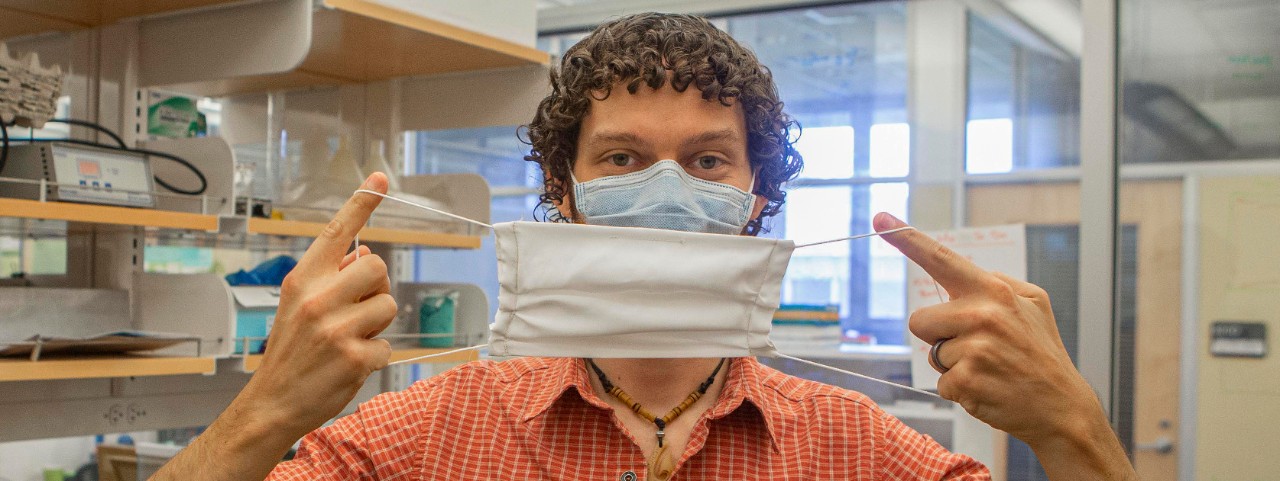
Silk offers homemade solution for COVID-19 prevention
UC biologists say silk face masks could provide better protection than cotton or synthetics
With personal protective equipment still in short supply, researchers at the University of Cincinnati examined what common household fabrics might work best as a face covering.
Next to a single-use N95 respirator or surgical mask, UC found the best alternative could be made by a hungry little caterpillar. Silk face masks are comfortable, breathable and repel moisture, which is a desirable trait in fighting an airborne virus.
Perhaps best of all, silk contains natural antimicrobial, antibacterial and antiviral properties that could help ward off the virus, said Patrick Guerra, assistant professor of biology in UC’s College of Arts and Sciences.
Studies have shown that copper, in particular, can kill bacteria and viruses on contact. And that’s where the little caterpillars have their own superpower, Guerra said.
“Copper is the big craze now. Silk has copper in it. Domesticated silk moths eat mulberry leaves. They incorporate copper from their diet into the silk,” Guerra said.
The project demonstrates UC's commitment to making an impact in the community as described in UC's strategic direction called Next Lives Here.
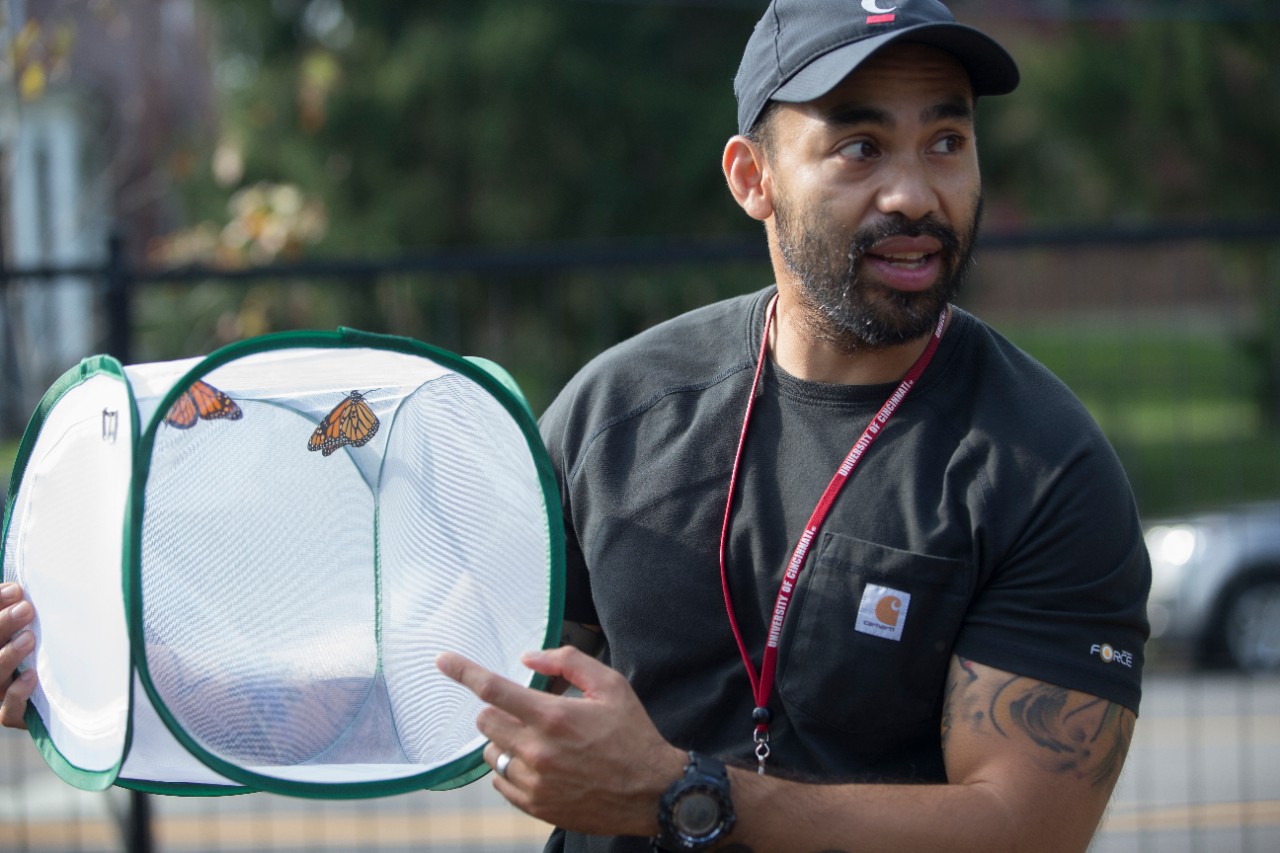
UC biologist Patrick Guerra has helped to unravel the mysteries of monarch butterfly migration. His knowledge of entomology inspired his research into silk masks. Photo/Lisa Ventre/UC Creative + Brand
Many health care providers are wearing a surgical mask in combination with an N95 respirator. The outer covering helps prolong the life of the N95 respirator by keeping it clean. Guerra, whose wife, Evelyn, is a medical doctor, said silk might be an especially good choice for this outer cover as they perform similarly to surgical masks that are in short supply.
“Cotton traps moisture like a sponge. But silk is breathable. It’s thinner than cotton and dries really fast,” Guerra said.
With COVID-19 surging in parts of the United States, face masks have become a focal point of prevention.
We’re trying to address this critical problem. Health care workers still don’t have enough personal protective equipment, namely N95 respirators or basic surgical masks.
Patrick Guerra, UC biologist
In the UC biology lab, researchers tested cotton and polyester fabric along with multiple types of silk to see how effective a barrier each is for repelling water, representing respiratory droplets containing the virus. They found that silk worked far better as a moisture barrier than either polyester or cotton, both of which absorb water droplets quickly.
UC’s study concluded that silk performs similarly to surgical masks when used in conjunction with respirators but has the added advantages of being washable and repelling water, which would translate to helping to keep a person safer from the airborne virus.
“The ongoing hypothesis is that coronavirus is transmitted through respiratory droplets,” Guerra said. “If you wore layers of silk, it would prevent the droplets from penetrating and from being absorbed. Recent work by other researchers also found that increasing layers of silk improves filtration efficiency. This means that silk material can repel and filter droplets. And this function improves with the number of layers.”
The study was published this month in the journal Plos One.
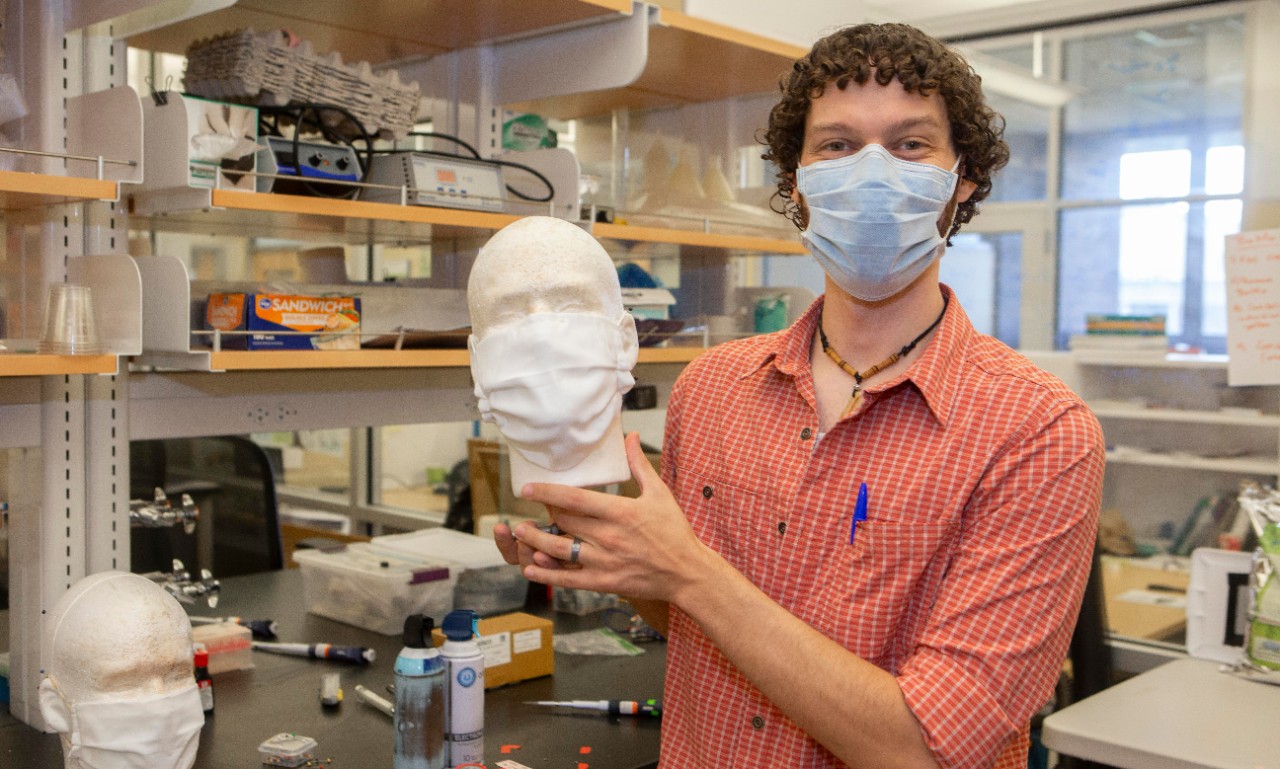
Postdoctoral researcher Adam Parlin holds up a styrofoam head draped with a silk mask. UC biologists examined how well face masks made from different materials repelled water or aerosolized droplets. Silk impeded the penetration and absorption of liquid and aerosolized droplets better than cotton or synthetic fabrics. Photo/Joseph Fuqua II/UC Creative + Brand
Because of the timeliness of their work during the global pandemic, UC researchers posted their results early to medRxiv, a preprint server for health sciences.
“We’re trying to address this critical problem. Health care workers still don’t have enough personal protective equipment, namely N95 respirators or basic surgical masks,” Guerra said.
Previously, Guerra studied the neurobiology behind the incredible multigenerational migration of monarch butterflies across North America. As an entomologist, he’s studied everything from giant lobster katydids in South America to Madagascar hissing cockroaches.
Now UC students raise silk moths (Bombyx mori) in Guerra’s biology lab.
UC postdoctoral researcher Adam Parlin wrote an undergraduate instruction manual for care and feeding of the moths he titled, “How to Train Your Bombyx,” a riff on the DreamWorks’ animated dragon movies. The cover features a picture of the adult moth. With its big head, enormous eyes and fanned wings, the silk moth indeed resembles a night fury from the films.
“These little guys are entertaining,” he said.
A time-lapse video shows a silkworm building a cocoon in 72 hours. Video/Adam Parlin
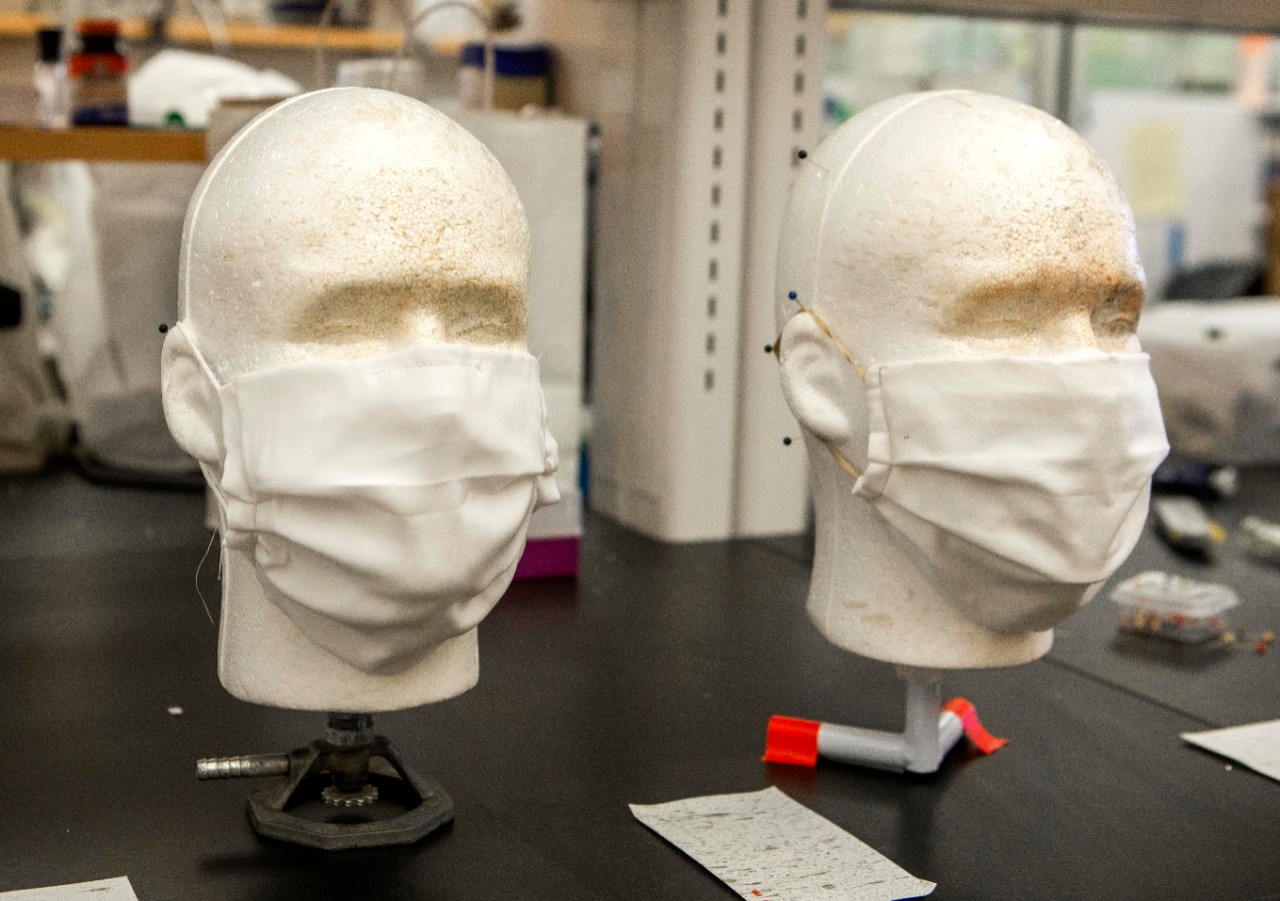
UC found that silk repelled moisture better than other common fabrics used in face masks. Photo/Joseph Fuqua II/UC Creative + Brand
As part of his research, Parlin studied how the caterpillars make their protective silk cocoons. When they reach a point in their life cycle, the caterpillars become manic workaholics. For 72 straight hours they spin and spin their silk to create a luxurious, breathable fortress where they can pupate safely into a fuzzy white moth.
Researchers created cardboard arenas with a wooden dowel in the center upon which the caterpillars can spin their silk cocoons. The caterpillars work methodically and nonstop, initially spinning silk from the top of the dowel at an angle to the cardboard like a tent. Once the tent is finished, they work in earnest on building their grape-sized cocoon in a corner of it.
“If the cocoon gets damaged, they just build a second layer around it,” Parlin said.
The moisture-trapping cocoon provides an ideal microclimate to keep the caterpillars happy despite any sudden changes in the weather.
“The silk cocoons prevent moisture from getting in and keeps the animal from desiccation or drying out,” Guerra said.
Now Guerra is investigating how long the virus survives on silk and other materials.
As shortages of personal protective equipment continue to plague health care providers, Guerra said homemade masks will continue to play an important role in keeping people safe from COVID-19.
“Silk has been with us for a while — since the days of the Silk Road,” Guerra said. “It’s not a new fabric, yet now we’re finding all these new uses for it.”
Featured image at top: UC postdoctoral researcher Adam Parlin holds up a silk face mask. A UC study found that silk masks might work better at repelling COVID-19 than cotton or synthetic masks. Photo/Joseph Fuqua II/UC Creative + Brand
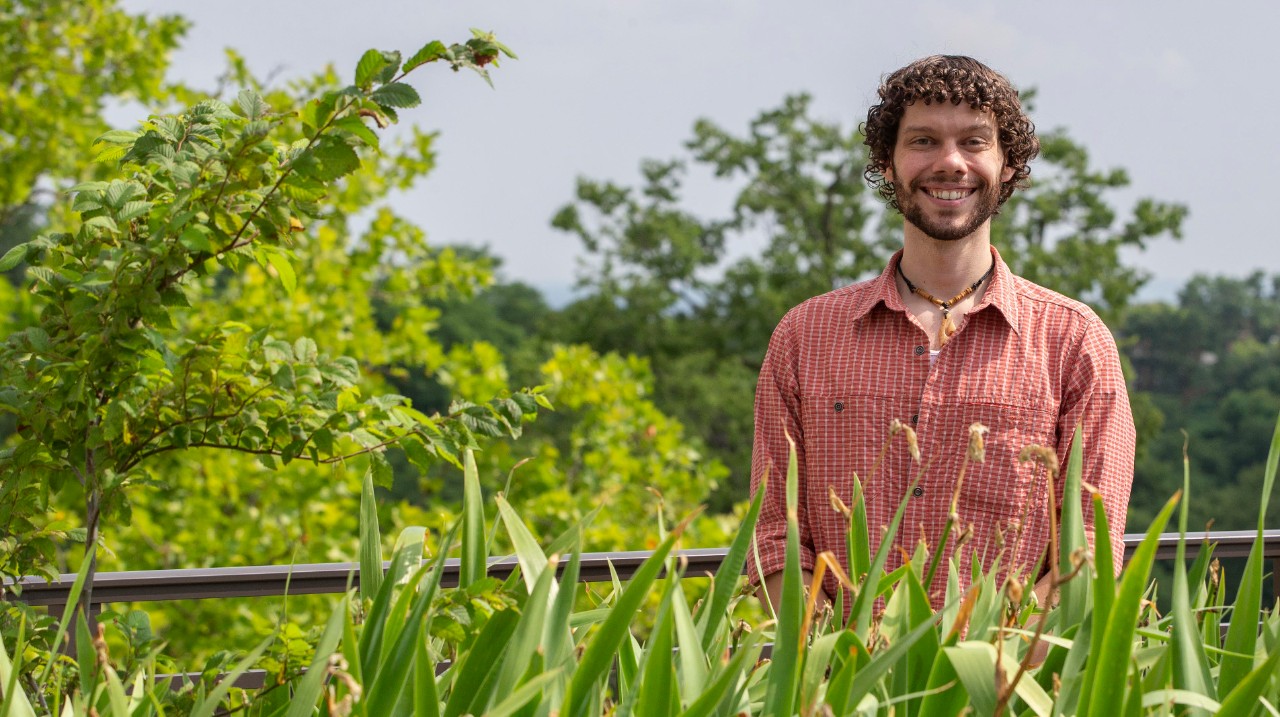
UC postdoctoral researcher Adam Parlin is studying butterfly migration in UC assistant professor Patrick Guerra's biology lab. Photo/Joseph Fuqua II/UC Creative + Brand
Impact Lives Here
The University of Cincinnati is leading public urban universities into a new era of innovation and impact. Our faculty, staff and students are saving lives, changing outcomes and bending the future in our city's direction. Next Lives Here.
Stay up on all UC's COVID-19 stories, read more #UCtheGood content, or take a UC virtual visit and begin picturing yourself at an institution that inspires incredible stories.
Related Stories
It’s a mindset: Meet the visionaries redefining innovation at...
December 20, 2024
Innovation is being redefined by enterprising individuals at UC’s 1819 Innovation Hub. Meet the forward thinkers crafting the future of innovation from the heart of Cincinnati.
UC’s spring Visiting Writers Series promises robust, diverse...
December 20, 2024
Lovers of literature, poetry and the written word can look forward to a rich series of visiting writer presentations, offered through UC’s College of Arts and Sciences department of English, coming this spring.
UC students well represented in this year’s Inno Under 25 class
December 20, 2024
Entrepreneurialism runs through the veins of University of Cincinnati students, as confirmed by the school’s strong representation in this year’s Inno Under 25 class.
